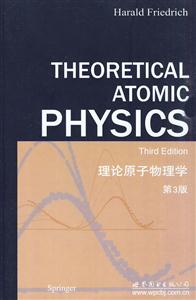理论原子物理学-第3版

|
理论原子物理学-第3版作者:弗里德里希(Harald Friedrich) 开 本:24开 书号ISBN:9787510005688 定价:60.0 出版时间:2010-04-01 出版社:世界图书出版公司 |
理论原子物理学-第3版 本书特色
《理论原子物理学(第3版)(英文版)》是由世界图书出版公司出版的。
理论原子物理学-第3版 内容简介
本书主要讲解量子力学基本原理在现代原子物理学中的应用。在新版中,作者增添了理论原子物理领域的*新进展,介绍了目前大家非常感兴趣的议题,包括半经典周期轨道理论、外场中原子的标度性质、双电子原子的经典和量子动力学以及原子气体的玻色-爱因斯坦凝聚等。本书还简明介绍了原子光学中若干前沿研究,这是目前和未来超冷原子实验必不可少的知识。作者强调基本理论的解释,使读者能够理解标准理论结构里蕴藏的丰富物理思想,从而可以独立进行科学研究工作。此外,形式各异的习题及其完整的解答过程为本书添色不少。本书被选为德国springer出版社的“高等物理学教材”,这是一套非常优秀的教材。目次:量子力学概要;原子和离子;原子光谱;简单反应;专题;附录:特殊数学函数;习题答案;索引。
原子物理是物理学中*具有活力的前沿领域之一,它在推动人们对自然界的认知方面发挥了重要作用。在过去几年里,该领域及相关领域因原子激光冷却(1997年)、玻色-爱因斯坦凝聚的实现(2001年)以及光的量子相干性与精密光谱学的发展(2005年)三次摘取诺贝尔物理学奖桂冠。读者对象:理论物理、原子分子物理和物理化学等专业的高年级本科生、研究生和相关领域的科研人员。
理论原子物理学-第3版 目录
1 review of quantum mechanics1.1 wave functions and equations of motion
1.1.1 states and wave functions
1.1.2 linear operators and observables
1.1.3 the harniltonian and equations of motion
1.2 symmetries
1.2.1 constants of motion and symmetries
1.2.2 the radial schrsdinger equation
1.2.3 example: the radially symmetric harmonic oscillator
1.3 bound states and unbound states
1.3.1 bound states
1.3.2 unbound states
1.3.3 examples
1.3.4 normalization of unbound states
1.4 processes involving unbound states
1.4.1 wave packets
1.4.2 transmission and reflection
1.4.3 time delays and space shifts
1.5 resonances and channels
1.5.1 channels
1.5.2 feshbach resonances
1.5.3 potential resonances
1.6 methods of approximation
1.6.1 time-independent perturbation theory
1.6.2 ritz's variational method
1.6.3 semiclassical approximation
1.6.4 inverse power-law potentials
1.7 angular momentum and spin
1.7.1 addition of angular momenta
1.7.2 spin
1.7.3 spin-orbit coupling
problems
references
2 atoms and ions
2.1 one-electron systems
2.1.1 the hydrogen atom
2.1.2 hydrogenic ions
2.1.3 the dirac equation
2.1.4 relativistic corrections to the schrodinger equation
2.2 many-electron systems
2.2.1 the hamiltonian
2.2.2 pauli principle and slater determinants
2.2.3 the shell structure of atoms
2.2.4 classification of atomic levels
2.3 the n-electron problem
2.3.1 the hartree-fock method
2.3.2 correlations and configuration interaction
2.3.3 the thomas-fermi model
2.3.4 density functional methods
2.4 electromagnetic transitions
2.4.1 transitions in general, "golden rule"
2.4.2 the electromagnetic field
2.4.3 interaction between atom and field
2.4.4 emission and absorption of photons
2.4.5 selection rules
2.4.6 oscillator strengths, sum rules
problems
references
3 atomic spectra
3.1 long-ranged and shorter-ranged potentials
3.1.1 very-long-ranged potentials
3.1.2 shorter-ranged potentials
3.1.3 the transition from a finite number to infinitely many bound states, inverse-square tails
3.1.4 example: truncated dipole series in the h- ion
3.2 one electron in a modified coulomb potential
3.2.1 rydberg series, quantum defects
3.2.2 seaton's theorem, one-channel quantum defect. theory
3.2.3 photoabsorption und photoionization
3.3 coupled channels
3.3.1 close-coupling equations
3.3.2 autoionizing resonances
3.3.3 configuration interaction, interference of resonances
3.3.4 perturbed rydberg series
3.4 multichannel quantum defect theory (mqdt)
自然科学 物理学 原子核物理学高能物理学
在线阅读
- 最新内容
- 相关内容
- 网友推荐
- 图文推荐
| [高考] 2022 西安电子科技大学《软件工程》大作业答案 (2022-04-25) |
| [家长教育] 孩子为什么会和父母感情疏离? (2019-07-14) |
| [教师分享] 给远方姐姐的一封信 (2018-11-07) |
| [教师分享] 伸缩门 (2018-11-07) |
| [教师分享] 回家乡 (2018-11-07) |
| [教师分享] 是风味也是人间 (2018-11-07) |
| [教师分享] 一句格言的启示 (2018-11-07) |
| [教师分享] 无规矩不成方圆 (2018-11-07) |
| [教师分享] 第十届全国教育名家论坛有感(二) (2018-11-07) |
| [教师分享] 贪玩的小狗 (2018-11-07) |






